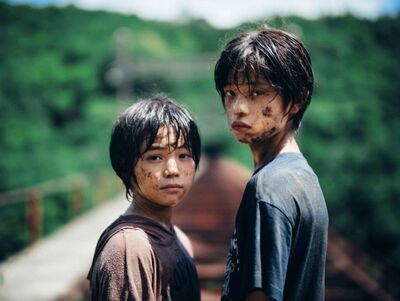
“Monster” does not, despite its title, see the Japanese director Hirokazu Kore-eda making an unprecedented turn into horror territory. The first film in competition to screen at Cannes this year, this melodrama finds the filmmaker back in Japan (after “Broker” and “The Truth“) and operating on familiar fractured-family turf, albeit from another writer’s screenplay. (Kore-eda usually pens his own material.)
The twist this time is that the story gets told from three perspectives. Something is clearly disturbing Minato (Soya Kurokawa), a fifth-grader being raised by his widowed mother, Saori (Sakura Ando); that is certainly clear by the time he jumps out of a moving car. Minato implies that some of the blame for his behavior is due to his teacher, Mr. Hori (Eita Nagayama), whom he says has physically hurt him. The school officials—including the principal (Yuko Tanaka), who herself may not be fully forthcoming—downplay the seriousness of the charge. Mr. Hori had simply issued an instruction that Minato misunderstood, they say. Mr. Hori didn’t actually hit Minato, they add, although they concede there was “contact” between the teacher’s hand and Minato’s nose.
Although Mr. Hori’s casual lack of concern while meeting with Saori and and the administrators is utterly inexplicable, Kore-eda loops back in time to show events from his point of view, which casts some doubt on who the aggressor is. The director then shows what Minato saw, and focuseson Minato’s relationship with a classmate (Hinata Hiiragi) who, it’s clear enough from earlier threads, might either be his close friend or his bullying victim.
This sort of chronological and point-of-view shuffling is unusual for Kore-eda, and it is interesting to see how he approaches it. He doesn’t quite repeat scenes, but instead generally cuts away just before we arrive at an event we’ve seen before. Where “Monster” ends up is not exactly revelatory, but it does have a lovely, ethereal piano score by Ryuichi Sakamoto, who died in March. The film is dedicated to him.
Another perspective-bender, but one set almost entirely in a courtroom, “The Goldman Case” opened the this year’s Directors’ Fortnight program. The subject is a famous French appeals case from the mid-1970s, when Pierre Goldman, a radical leftist born to Polish Jews in France in 1944, attempted to prove that he was innocent of the killings of two pharmacists. He admitted to other crimes, but not to that one.

As played by Arieh Worthalter, Goldman, who in prison wrote a book about his case and became a cause of the French left, is a rivetingly belligerent defendant who resists what he sees as the pomp and theatricality of the court’s proceedings. What’s the point of having character witnesses, he asks, when he is clearly a disreputable character? That doesn’t make him a murderer. He wants to make his case on the basis of facts alone. His innocence, he says, is “ontological.” And while fans of courtroom thrillers will get all their favorite staples—witnesses being impeached, passionate closing statements from both sets of lawyers—it’s the devotion to cold precision that makes “The Goldman Case” a superior example of the genre.
“The Goldman Case” turns, in part, on the legacy of the Holocaust in France; it’s been suggested that anti-Semitism played a role in Goldman’s original conviction. This year in the official selection, the director Steve McQueen has a four-hour-plus nonfiction film, “Occupied City,” that presents an exhaustive account of Amsterdam during the Holocaust. It is billed as being “informed” by the book “Atlas of an Occupied City (Amsterdam 1940-1945),” which was written by McQueen’s wife, Bianca Stitger, who is a filmmaker herself (“Three Minutes: A Lengthening“).
Radically unadorned, “Occupied City” consists, for four hours, of scenes of contemporary Amsterdam overlaid with narration reciting events and actions at specific addresses: sites where Jews where ghettoized or forced to buy yellow stars; buildings where resistance members carried out activities; a square cited as the last place in the Netherlands where Jews were allowed (which now appears to be a bocce court). The text is by Stitger, and the narration is read by Melanie Hyams.
The approach—seeing the past in present-day locations—owes something to “Shoah,” although the organizing principle here is less lear. (The anecdotes are not chronological, and seemingly not even geographically arranged; McQueen circles back to certain areas.) Some of the most powerful moments involve sites that are still in use in some form today. (Should you ever take a train through Amsterdam’s Centraal Station, note that, according to the film, an estimated one-quarter of the city’s Jews “departed” through that station in the war years.) Omissions are also suggestive; I could have missed it, but I don’t think “Occupied City” ever shows the Anne Frank House, one of Amsterdam’s most famous locations, although Frank is certainly mentioned.
One aspect of the film is uneasy-making. McQueen shot much of “Occupied City” while Amsterdam was shut down during Covid, and some of the juxtapositions he creates in the editing are a tad suspect. Surely when the film indicates that a square used as an assembly point for the roundup of Jews during the Holocaust is now a vaccination center, or that curfews were used in both periods, we’re not meant to see a literal parallel.
***

Pedro Almodóvar’s half-hour western, “Strange Way of Life,” which premiered at Cannes this afternoon, is a pretty minor exercise, a chance for both the director and the actors to try on some cowboy duds for no reason in particular. The film centers on Jake, a sheriff, and Silva (Pascal), a rancher he worked with as a hired gun 25 years ago. They were also lovers, and when they reunite at the start of the film, they are much more open about that past than, say, Jake Gyllenhaal and Heath Ledger’s characters in “Brokeback Mountain.”
But sex aside, “Strange Way of Life” consists of little more than a basic sketch for a showdown. (Jake plans to track down Silva’s son for committing a murder, and Silva wants Jake to leave him be.) Given 70 minutes, Budd Boetticher might have mined some dark ambiguities from the scenario while building toward the eventual three-man confrontation. But the rhythms here are off, and the tension is nonexistent.




